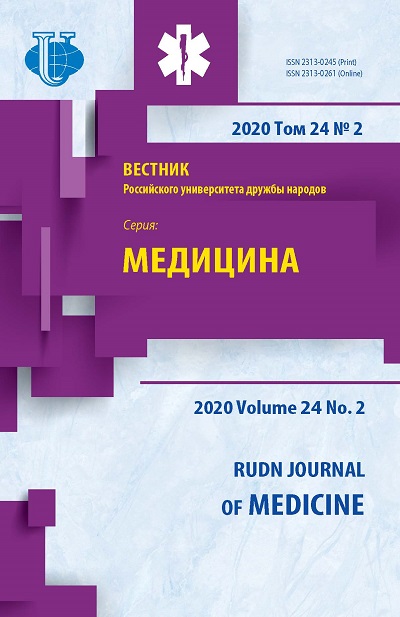Low molecular weight bioregulator of bacterial origin in condylomatosis therapy optimization
- Authors: Abramashvili Y.G.1, Kolesnikova N.V.1, Borisova O.Y.2,3, Guryanova S.V.3,4
-
Affiliations:
- Kuban State Medical University of the Ministry of Health of Russia
- Moscow Research Institute of Epidemiology and Microbiology named after G.N. Gabrichevsky
- Shemyakin and Ovchinnikov Institute of Bioorganic Chemistry RAS
- Peoples’ Friendship University of Russia
- Issue: Vol 24, No 2 (2020)
- Pages: 163-167
- Section: IMMUNOLOGY
- URL: https://journals.rudn.ru/medicine/article/view/23812
- DOI: https://doi.org/10.22363/2313-0245-2020-24-2-163-167
- ID: 23812
Cite item
Full Text
Abstract
Condylomatosis is a disease characterized by the formation on the surface epithelium of the skin and mucous outgrowths, which can reach significant sizes. The cause of the disease is DNA-containing human papillomavirus (HPV), which have a high affinity for epithelial tissues of the genital organs, esophagus, anal canal and respiratory tract. Clinicians have described various patterns of use of the drug Liсopid in the treatment of condylomatosis. Of interest is the development and further implementation of condylomatosis therapy using a drug based on glucosaminyl muramyl dipeptide in order to correct immunodeficiency states and treat papillomavirus infection. Clinical condylomatosis of the external genitalia is presented. In the study of PCR on HPV, 33 types with a high viral load were detected. Diagnosis: Papillomavirus infection. Condylomas of the external genitalia. The goals of therapy and the treatment regimen: prescribing the drug Liсopid (AO Peptek, Moscow) to activate innate immunity, which allows to get an adequately high immune response at the level of both cellular and humoral local immunity. After the therapy, condylomas of the external genital organs were not found at the examination. The patient notes an improvement, the disappearance of itching. Thus, condylomatosis therapy according to the standard 10 mg Liсopid regimen for 10 days was effective, it contributed to the disappearance of genital warts, the clinical effect persisted for the entire observation period - 3 months. The clinical effectiveness of the drug can be explained by its systemic effect on the correction of immunity through NOD2 receptors.
About the authors
Yu. G. Abramashvili
Kuban State Medical University of the Ministry of Health of Russia
Author for correspondence.
Email: svgur@mail.ru
Krasnodar, Russian Federation
N. V. Kolesnikova
Kuban State Medical University of the Ministry of Health of Russia
Email: svgur@mail.ru
Krasnodar, Russian Federation
O. Yu. Borisova
Moscow Research Institute of Epidemiology and Microbiology named after G.N. Gabrichevsky; Shemyakin and Ovchinnikov Institute of Bioorganic Chemistry RAS
Email: svgur@mail.ru
Moscow, Russian Federation
S. V. Guryanova
Shemyakin and Ovchinnikov Institute of Bioorganic Chemistry RAS; Peoples’ Friendship University of Russia
Email: svgur@mail.ru
Moscow, Russian Federation
References
- Adaskevich V.P. Sexually transmitted diseases. Vitebsk. 1997. 310 p.
- Bouvard V, Baan R, Straif K, et al. WHO International Agency for Research on Cancer Monograph Working group. A review of human carcinogens-Part B: biological agents. Lancet Oncol. 2009;10:321–2.
- Andronova T.M., Ivanov V.T. The structure and immunomodulating function of glucosaminylmuramyl peptides. Sov. Medical Review J. Immunology. 1991;4:1–63.
- Pinegin B.V., Pashchenkov M.V. Muramyl peptide immunostimulants in the treatment and prevention of infectious and inflammatory processes. Immunology. 2019;3:65–71.
- Guryanova S., Udzhukhu V., Kubylinsky A. Pathogenetic therapy of psoriasis by muramyl peptide. Frontiers in Immunology. 2019. Т. 10. P. 1275–1283. doi: 10.3389/fimmu.2019.01275
- Kolesnikova N.V., Kozlov I.G., Guryanova S.V., Kokov E.A., Andronova T.M. Clinical and immunological efficacy and prospects for the use of muramyl dipeptides in the treatment of atopic diseases. Medical immunology. 2016;18:(1):15–20.
- Guryanova S, Andronova T. Bacterial Cell Wall Fragment Glucosaminyl Muramyl Dipeptide In Treatment Of Allergic Disease. Allergy: European Journal of Allergy and Clinical Immunology. 2019.V.74.S.106. PD0590.
- Guryanova SV, Kozlov I.G., Meshcheryakova E.A., Alekseeva L.G., Andronova T.M. Glucosaminylmuramyl dipeptide normalizes the Th1 / Th2 balance in atopic bronchial asthma. Immunology. 2009;5:305–8.
- Pinegin B.V., Pashchenkov M.V. Muramyl peptide immunostimulants in the treatment and prevention of infectious and inflammatory processes. Immunology. 2019;3:65–71.
- Yushchenko A.A. Comparative evaluation of the effect of leukinferon and lycopid on phagocytic microbicidal factors in experimental leprosy. In: Immunodiagnosis and immunorehabilitation in leprosy, tuberculosis and other chronic diseases. M. 1998. 97 p.
- Pynzar MA, Agikova LA, Minkina G.N. Clinical experience with the use of the Likopid immunomodulator in patients with bacterial vaginosis. Immunology. 1998;5:63–4.
- Kharlova O.G. The use of the new immunomodulator GMDP in the treatment of patients with cervical papillomavirus infection. Immunology. 1997;1:49–51.
- Balabolkin II, Kuznetsova NI, Kuznetsova O. Yu., Changes during treatment with lycopide in the immune status of children with recurrent herpetic stomatitis, suffering from allergic diseases. Dentistry. 2004;3:49–52.
- Guryanova Svetlana, Andronova Tatyana M., Kozlov Ivan G. The Role of NOD2 Ligands Muramyl Peptides in Chemotherapy Induced Cytopenia. European Journal of Immunology. 2019. V. 49. S.3, P0951. https://onlinelibrary.wiley.com/doi/epdf/10.1002/ eji.201970400
- Manapova E.R., Fazylov V. Kh., Guryanova S.V. cytopenia and their correction in antiviral therapy of chronic hepatitis C in patients with genotype 1. Problems of Virology. 2017; 62 (4):174–8.
- Pinegin B.V., Minkina G.N., Manukhin I.B. The effect of glucosaminylmuramyl dipeptide on the immune status and clinical condition of patients with cervical lesions of the human papilloma virus. Immunology. 1994;3: 46–9.
- Manukhin I.B., Minkina G.M., Vysotsky M.M., Kharlova O.G. Comprehensive treatment of patients with local and common condylomatosis of the cervix. Questions of gynecology, obstetrics and perinatology. 2005;4(1):20–4.
- Megevitinova E.A., Prilepskaya V.N., Rogovskaya S.I. Genital warts caused by human papillomavirus infection. Breast Cancer. 1998; 5:309–11.
- Rogovskaya S.I., V.N. Prilepskaya, E.A. Mezhevitinova, Kostava M.N. Papillomavirus infection of the genitals in women. Bulletin of Dermatology and Venereology. 1998;6:48–51.
- Namasivayam A.A., Bobbili D.R., Androsova G., Biryukov M., Narayanasamy S., Arbas S.M., et al. Community-reviewed biological network models for toxicology and drug discovery applications. Gene Regulation and Systems Biology. 2016;10:51–66.
- Hoeng J., Boue S., Peitsch M.C., Schlage W.K., Talikka M., Fields B., et al. Enhancement of COPD biological networks using a web-based collaboration interface. F1000Research. 2015. Т. 4. С. 32. Abramashvili Yu.G. et al. RUDN Journal of Medicine, 2020, 24 (2), 163—167
Supplementary files















